This content has been independently produced in adherence to a strict honesty policy, but note that it contains affiliate links. When you buy via these, we may receive a commission.
In this post, we show you how to do keyword research with Semrush. Read on for an explanation of what keyword research is; how it can help your business; and how to do it right.
Ranking highly in search results for the right keywords is one of the best things you can do to drastically improve your online visibility — and, by extension, your business’ profitability.
So, below you’ll find a simple guide to keyword research with Semrush that walks you through the process, step-by-step. Read on to learn how you can identify the most relevant and valuable keywords for your business — and use them effectively on your website.
Let’s start things off with a key question…
What is keyword research?
Keyword research is a process of identifying queries (‘keywords’) that people enter into search engines when searching for particular products or services.
When you know precisely what people are searching for in your business area, you can adjust your website and its content in ways that give it the best chance of appearing in search results for those keywords.
Keyword research is also useful for understanding demand (how many people are searching for a particular item in a given timeframe) and for tracking changes in consumer interests.
Why do you need to do keyword research?
There are four key reasons why you might want to conduct keyword research:
- It lets you identify the exact phrases people use when searching for the sort of products and services you sell.
- It reveals how hard it will be to rank for a given search query.
- It lets you estimate your maximum traffic potential.
- It helps you create more relevant content, because it shows you which keywords you have to target, and which stage of the purchasing journey your potential customers are at.
But how do you do it?
Well, the first step is to get your hands on a keyword research tool.
Picking a keyword research tool
You can’t perform keyword research effectively without access to keyword research tools.
A keyword research tool shows you:
- the search queries people are using
- the volume of searches for these phrases each month
- how hard it will be to rank for these terms
- suggestions for queries that are easier to rank for.
Now, you may be thinking that because Google is the world’s number 1 search engine, it might be best to get this data straight from the horse’s mouth.
And to be fair, there are a couple of Google tools that can help with this a bit: Google Keyword Planner and Google Search Console.
However, they have their limitations when it comes to keyword research:
- Google Keyword Planner can show you how many people search for particular phrases each month — but only if you’ve spent quite a lot of money on ads.
- Google Search Console only shows metrics for keywords you already rank for. This means that you won’t be able to use it for actual keyword research, as it’s only suitable for analyzing your current search performance.
So, to perform the best keyword research, you generally need to invest in a dedicated SEO tool.
Now if you Google “the best keyword research tools,” you’ll see three names popping up frequently: Semrush, Moz and Ahrefs.

For our take on how these SEO tools stack up against each other, you can read our comparison reviews — check out our Semrush vs Ahrefs, Semrush vs Moz and Ahrefs vs Moz articles.
But for the purposes of this post, I’m going to show you how to do keyword research with Semrush.
Now, if you’re using another keyword research tool, not to worry: the keyword research process I outline below will work in a broadly similar way.
Important: if you want to try the below steps out with Semrush, you’ll need an account. For a limited time only, Style Factory readers can avail of a double-length free trial of the platform here.
Once you’ve picked your keyword research tool, it’s time to get stuck into the actual business of keyword research.
There are three main steps involved with this:
- Brainstorming to identify ‘seed’ keywords.
- Expanding your seed keyword list with suggestions from your SEO tool.
- Going through your list, proritizing your keywords and identifying the best ones to create content for
Let’s go through steps these now, starting with the brainstorming part.
Step 1: Brainstorm
The very first step is all about brainstorming. And it’s split into two parts:
1) An actual brainstorm (ideas you get from the ‘top of your head’).
2) A data-driven brainstorm (keyword ideas you generate by examining what your competitors are currently ranking for).
Let’s look at the ‘actual’ brainstorm — your intuitive guesses — first.
Identifying seed keywords through ‘actual’ brainstorming
If you have a small business, you probably know your industry pretty well.
This should help you come up with an initial set of ‘seed’ or ‘first-stage’ keywords — words that you instinctively think people will use when searching for the sort of services you offer.
Let’s imagine that you own a small house cleaning service.
You might already have a few seed keywords in mind that people might use when searching for your kind of business — for example:
- ‘House cleaners’
- ‘Cleaning service’
- ‘Clean house’
- ‘Housekeeping’
- ‘Cleaning’
And so on.
But building your SEO strategy around these specific search terms isn’t a great idea.
Yes, these phrases will have a high search volume — meaning a lot of people search for them every month.
But they are too ‘broad’ and competitive in nature, and in truth you are very unlikely to rank for them on day one — especially if you’re a new business, or one that hasn’t previously put much effort into SEO.
However, these keywords are still going to form a valuable part of the keyword research process. So keep these phrases to hand — you will need them in a moment!
Expanding your initial keyword list through data-driven brainstorming
The next thing you need to do is to turn to competitive intelligence in search of more ‘first-stage’ keyword ideas.
To do this though, you’ll need to find out who your competitors are.
And the easiest way to find your online rivals is to simply enter the ‘seed keywords’ you’ve generated in the previous step into Google.
The search engine will then return the most relevant search results for your area, with the companies that show up here typically being your biggest competitors.
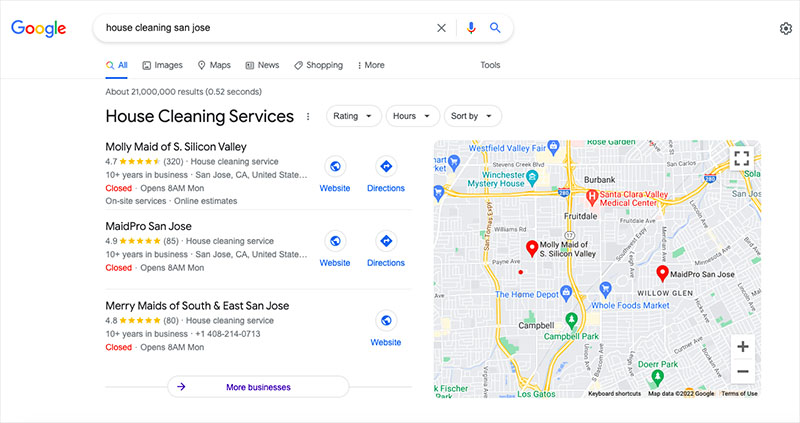
Tip: make sure you’re looking at organic search results here, not paid-for ads (the latter usually have a little ‘Sponsored’ or ‘Ad’ label beside them).
Next, you need to find out what phrases these competing businesses are currently ranking for in search results.
To do this, you can use Semrush’s Organic Research tool. You’ll find this on the left hand side of the Semrush interface, in its ‘competitive research’ section.
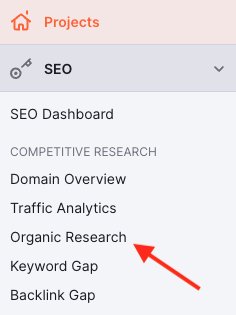
Simply enter a rival’s site URL into the Organic Research tool and it will immediately return an overview of the keywords that this competitor is ranking for.
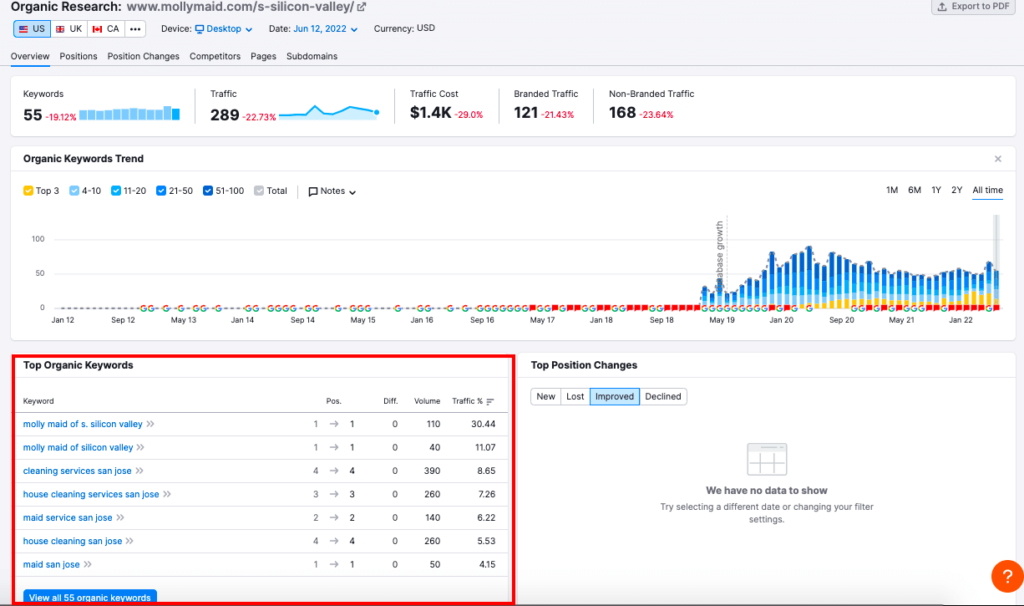
Then, click the ‘View all organic keywords’ button to see the full list.
Now, you’ll usually see a quite a large number of search terms here. Ideally, you should review the entire list, but if you’re short on time and resources, pay attention to the keywords with the highest search volume — you want to shortlist the ‘juiciest’ keywords with the biggest potential to drive traffic.
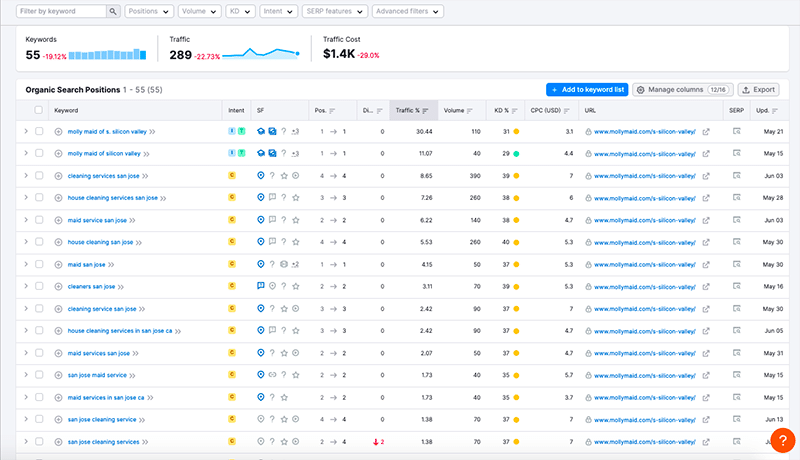
As you go through this process, tick the checkbox beside any keyword you’re interested in focusing on for your business, and when done, either export these phrases from Semrush into a CSV or Excel file (using the ‘Export’ button) or send them to Semrush’s Keyword Manager (a feature that helps you manage your keyword lists).
Doing this means that you’ll be able to refer back to your target keywords easily at any stage.
Another thing you can do in your data-driven brainstorm is find keywords that your rivals rank for but you don’t.
To do this, you can use Semrush’s Keyword Gap tool. Enter your website’s URL into this tool along with your competitors’ website addresses and you’ll get a list of all the keywords that they are ranking for but you’re not.
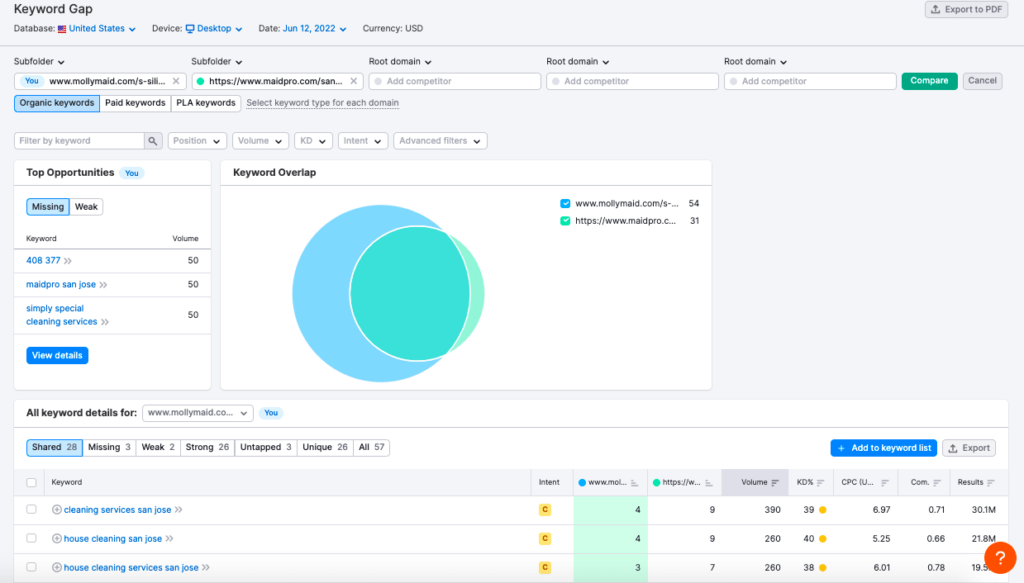
Again, add any relevant keywords this process surfaces to your keyword list.
Step 2: Expand your initial keyword list via keyword suggestions
Step one will have given you plenty of keywords to think about. But they might not be the ones you should target.
Why?
Well, your ‘first-stage’ keywords are likely to be short, broad and highly competitive terms.
These are typically known as ‘head keywords.’
Head keywords can bring a lot of visitors to a site — but visitors that might not necessarily convert into paying customers.
Just think about the phrase ‘cleaning’ — one of the words you might have come up with as part of your ‘seed keywords’ brainstorm. A person entering this into Google might want to open a cleaning service company, read up on carpet cleaners or research a bunch of cleaning-related services that your house-cleaning company simply isn’t offering.
It’s a very ‘open-ended’ query — so even if people ended up on your website as a result of entering it into Google, there’s no guarantee that they’d buy anything from you.
So, what you need to do is identify and target more relevant, long-tail keywords.
As their name suggests, long-tail keywords are longer phrases: they’ll typically involve a phrase you’re hoping to rank for, accompanied by ‘modifier’ words — for example, ‘Apartment cleaning service in San Jose’ would be a long-tail keyword; ‘cleaning’ would be a head keyword.
Long-tail keywords generate more relevant traffic — but, because they have lower search volumes and are less ‘obvious’ in nature than ‘head’ keywords, they are more prone to being ignored by other businesses.
And this makes them easier to rank for.
So your job is to find good long-tail keywords, and you can use your ‘seed keywords’ to help you.
Let’s take a look at how to do that.
Using your seed keywords to find long-tail keywords
Once you have a list of seed keywords, you can use Semrush’s Keyword Magic Tool to surface long-tail keywords related to them.
(You’ll find the Keyword Magic tool on the left hand side of the Semrush interface, in the ‘Keyword Research’ section.)
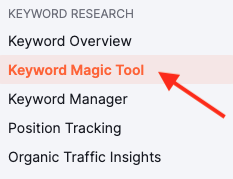
Upon entering a seed keyword into the Keyword Magic tool, Semrush will show you a list of keywords that you might want to consider targeting.
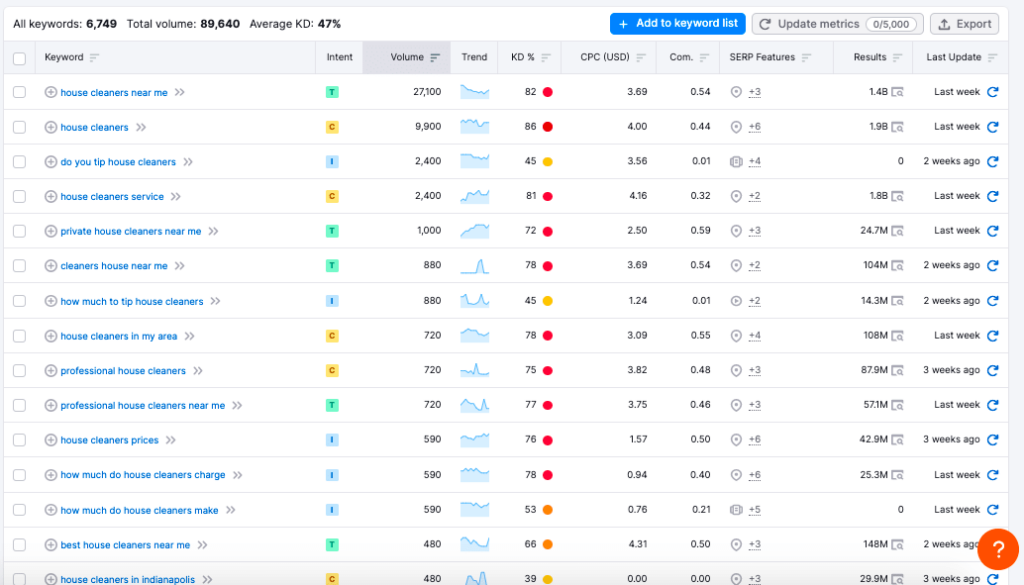
You can use a variety of filters within Semrush to refine the results shown — for example, you can ask Semrush to show you ‘broad match,’ ‘phrase match,’ ‘exact match’ or ‘related’ phrases. You can also view a list of questions involving the keyword you entered (this is a particularly useful filter, given that Google is often used as a question and answer tool).
Have a play around with the options provided and pick any keywords that seem like a good fit for your business. You should keep these in your spreadsheet or add them to Semrush’s Keyword Manager tool.
And then…
Step 3: Prioritize keywords
At this stage, you’ll have a solid keyword list to work with. But it’ll probably be very long — and the prospect of trying to rank for every phrase on the list will seem daunting.
So, your job here is to prioritize which keywords to try to rank for.
But how?
The answer lies in the metrics that Semrush provides — and the keyword spreadsheet you created earlier (whether that’s an Excel file or a Keyword Manager list) will contain a lot of these.
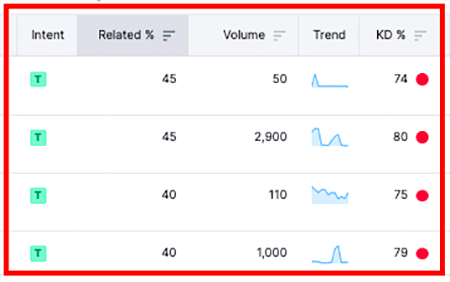
To decide which of the keywords in your list to focus on when creating new content, you need to pay attention to three key metrics:
1. Search volume
This metric tells you how many people search for a given query each month. The higher this number, the more traffic you’ll likely receive.
2. Keyword difficulty
This metric reflects how hard it is to rank for a given keyword. The lower the difficulty, the better.
3. Trend
The ‘Trend’ metric displays changes in the level of interest in the search term over a one-year period. If you encounter two keywords with similar search volume and keyword difficulty, but spot that one, unlike the other, comes with an upward search trend, you should prioritize the trending one.
All these metrics can help you find the ‘low-hanging fruits’ in your keyword list and enable you to prioritize your keyword optimization and content creation efforts more effectively.
The golden rule is to focus on the keywords that have higher search volume and lower keyword difficulty.
Using Semrush’s secret weapon to spot good keywords: keyword intent
Semrush is unique amongst the major keyword tools in accompanying each of its keyword suggestions with information about the ‘intent’ that somebody has when using a particular search query.
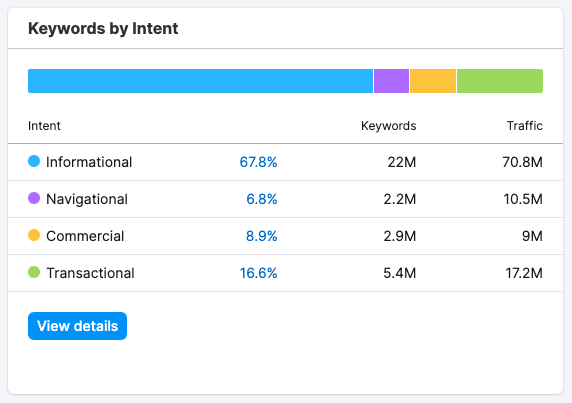
There are four types of ‘intent’ that Semrush highlights:
- Transactional intent: where the searcher is ready to complete an action and/or make a purchase (i.e., bottom of sales funnel).
- Commercial intent: where the searcher is investigating brands and services (middle of sales funnel)
- Informational intent: where a user is simply looking for an answer or some general information (top of sales funnel).
- Navigational intent: this implies that a user wants to find a particular website, page, or location.
In addition to factoring in search volume and keyword difficulty into your decision making process, you can use these ‘intent’ metrics to decide which of the keywords on your list are the best ones to focus on.
Which intent type works best for you will depend on your business type, but in most cases, it’s best to try to identify ‘transactional’ keywords that have a high search volume but are possible to rank for.
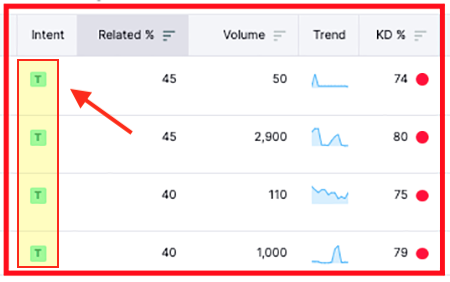
And now…create some great content!
By now you should have a list of keywords that…
- are relevant to your business
- generate a good number of searches each month
- are possible to rank for.
But these keywords aren’t any use unless they form the basis of some great content: Google’s algorithm doesn’t just factor in what keywords are present in a piece of text, but how well-written, interesting and relevant it is too.
So, your job is now to create some really engaging material for your site that is centred around your priority keywords.
Semrush provides a handy table which provides some suggestions on the type of content that’s best suited to its four categories of keyword intent:
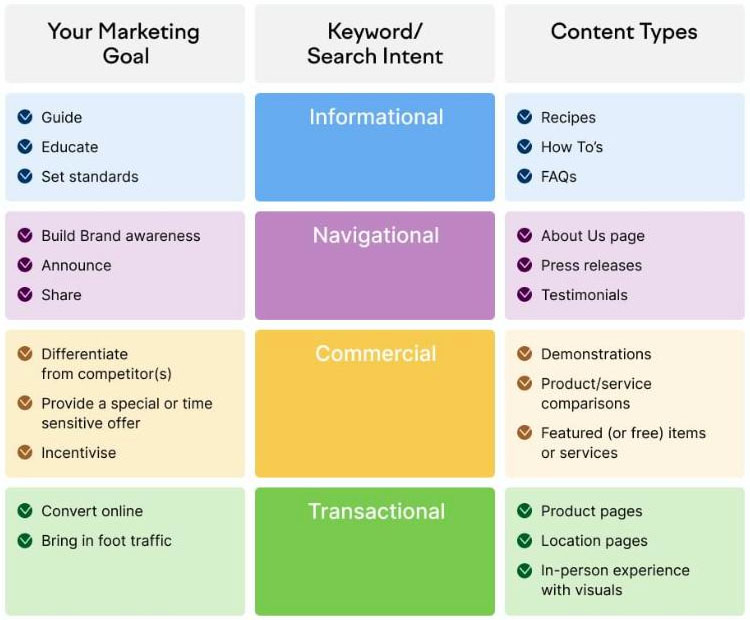
Source: Semrush Blog
Regardless of the type of content you end up creating however, you should always aim to make it clear, compelling and highly relevant to the keyword you’re targeting.
Check out our video below (on generating high-traffic blog posts) for some key tips on how to go about this effectively.
Wrapping Up
I hope you’ve found this guide to performing keyword research with Semrush helpful! If you are new to the tool, you can for a limited time only access a double length version of it here (the normal trial lasts just 7 days).
To wrap up, here’s a quick cheatsheet on how to conduct your research effectively:
- Brainstorm to identify ‘seed’ or ‘first stage’ keywords
Use your knowledge of your business area — and analysis of the keywords your competitors are ranking for — to identify ‘seed’ keywords that can form the basis of more detailed keyword research. - Use your seed keywords to find more valuable ‘long tail’ search terms
Enter your seed keywords into Semrush’s ‘Keyword Magic’ tool to find a list of related (and most likely ‘long tail’) keywords. - Prioritize keywords based on search volume, keyword difficulty and search intent metrics
Go through your list of seed keywords and keyword suggestions and make a shortlist of the ones for which there is a high search volume, low keyword difficulty and relevant search intent. - Create engaging content around your keyword shortlist
Use your keyword shortlist to create content that is engaging, relevant to the search terms you want to rank for and matches user intent.
And finally, here are a few helpful questions to ask yourself when going through your keyword shortlist:
- Have I picked the keywords with the highest traffic potential?
- How stiff is my competition? What are the odds of ranking number one for a given keyword?
- Do I already have content that can simply be tweaked to match my chosen keywords? Or do I have to create it from scratch?
- Do I already rank for some of these keywords, and, if yes, what can I do to improve my positions and get more traffic?
Good luck with your keyword research! And if you have any queries about how do to it right, do leave a comment below. We read all user queries and will do our best to help.
Semrush keyword research FAQ
Is Semrush good for keyword research?
Yes. Its keyword database is one of the largest available, and the tool gives you an extensive set of features that can help you identify the best target phrases for your SEO project. (You can learn more about all of the platform’s pros and cons in our Semrush review.)
How does Semrush get keyword data?
Semrush uses third-party providers to collect data from Google’s search results pages for the 500 million most popular keywords.
What is search intent?
Search intent (sometimes referred as “keyword intent”) refers to the the main goal a user has when typing a query into a search engine. Semrush breaks these down into four categories: informational, commercial, navigational and transactional.
Can I use Semrush for free?
Yes — a cut-down version of the platform is available, or you can test the fully-functional version for a limited period via its free trial.
What is the best tool for keyword research?
It depends on your requirements and budget, but key SEO tools to investigate are Semrush, Moz and Ahrefs.
No comments